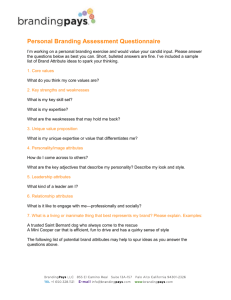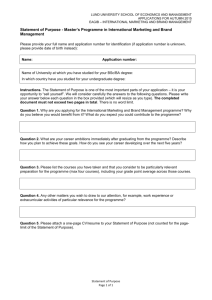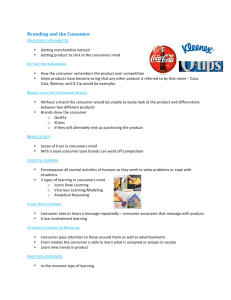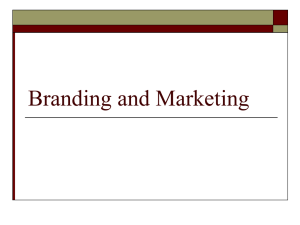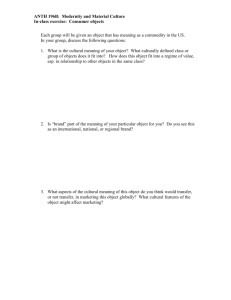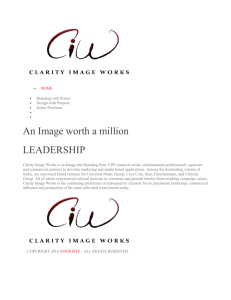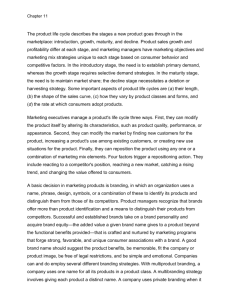Brand Building 2011
advertisement
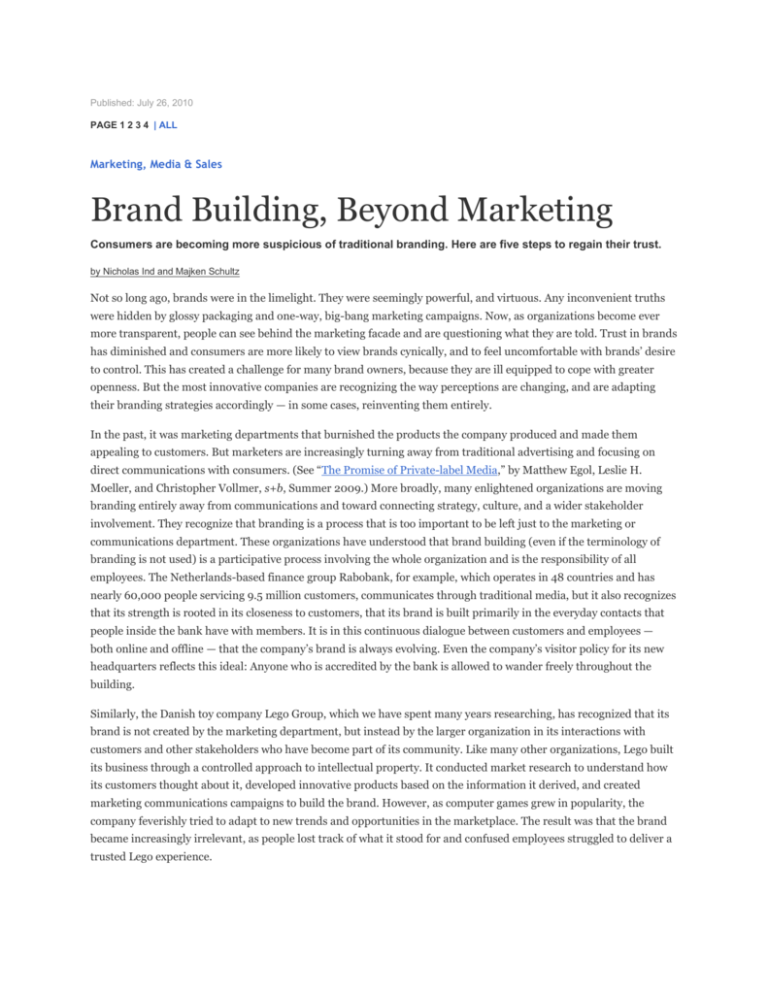
Published: July 26, 2010 PAGE 1 2 3 4 | ALL Marketing, Media & Sales Brand Building, Beyond Marketing Consumers are becoming more suspicious of traditional branding. Here are five steps to regain their trust. by Nicholas Ind and Majken Schultz Not so long ago, brands were in the limelight. They were seemingly powerful, and virtuous. Any inconvenient truths were hidden by glossy packaging and one-way, big-bang marketing campaigns. Now, as organizations become ever more transparent, people can see behind the marketing facade and are questioning what they are told. Trust in brands has diminished and consumers are more likely to view brands cynically, and to feel uncomfortable with brands’ desire to control. This has created a challenge for many brand owners, because they are ill equipped to cope with greater openness. But the most innovative companies are recognizing the way perceptions are changing, and are adapting their branding strategies accordingly — in some cases, reinventing them entirely. In the past, it was marketing departments that burnished the products the company produced and made them appealing to customers. But marketers are increasingly turning away from traditional advertising and focusing on direct communications with consumers. (See “The Promise of Private-label Media,” by Matthew Egol, Leslie H. Moeller, and Christopher Vollmer, s+b, Summer 2009.) More broadly, many enlightened organizations are moving branding entirely away from communications and toward connecting strategy, culture, and a wider stakeholder involvement. They recognize that branding is a process that is too important to be left just to the marketing or communications department. These organizations have understood that brand building (even if the terminology of branding is not used) is a participative process involving the whole organization and is the responsibility of all employees. The Netherlands-based finance group Rabobank, for example, which operates in 48 countries and has nearly 60,000 people servicing 9.5 million customers, communicates through traditional media, but it also recognizes that its strength is rooted in its closeness to customers, that its brand is built primarily in the everyday contacts that people inside the bank have with members. It is in this continuous dialogue between customers and employees — both online and offline — that the company’s brand is always evolving. Even the company’s visitor policy for its new headquarters reflects this ideal: Anyone who is accredited by the bank is allowed to wander freely throughout the building. Similarly, the Danish toy company Lego Group, which we have spent many years researching, has recognized that its brand is not created by the marketing department, but instead by the larger organization in its interactions with customers and other stakeholders who have become part of its community. Like many other organizations, Lego built its business through a controlled approach to intellectual property. It conducted market research to understand how its customers thought about it, developed innovative products based on the information it derived, and created marketing communications campaigns to build the brand. However, as computer games grew in popularity, the company feverishly tried to adapt to new trends and opportunities in the marketplace. The result was that the brand became increasingly irrelevant, as people lost track of what it stood for and confused employees struggled to deliver a trusted Lego experience. The revitalization of the Lego brand was not a master stroke by the marketing department, but the result of a close dialogue with key stakeholders spearheaded by a new CEO, Jørgen Vig Knudstorp, who took office in 2004. He realized that customers, who were using and adapting — and in some cases infringing upon — the Lego Group’s intellectual property, were not threatening the brand, but were actually redefining it. (See “The Promise (and Perils) of Open Collaboration,” by Andrea Gabor, s+b, Autumn 2009.) One of the secrets of Lego’s ability to engage its stakeholders with the brand is that it took advantage of the small opportunities that emerged along the way: from giving consumers the “right to hack,” to inviting small groups of passionate consumers to headquarters to work with the designers on new ideas, to the new CEO accepting the invitation to talk to the brand community on their turf. Many of these small openings have later had significant implications. By opening itself up to an active involvement with these enthusiasts, the company has been able to tap into a rich vein of innovative thinking and has been able to once again make the brand relevant. A New Role for Branding The Lego Group is an interesting example of open innovation, but it is more than that. It indicates a significant shift in the way we think about brands and points to a future that will be radically different — one in which brand building will involve all stakeholders, and where managers will have to give up the idea of control over a brand and accept instead a fluid, uncertain world where a brand evolves in dialogue with others. This in turn will require both openness and trust. Although we might argue that the very essence of brands is about trust — in the sense that consumers should be able to trust the promise that a brand name makes — in reality trust has often been missing. Organizations have trusted neither their customers nor their employees. As Francis Fukuyama notes in his book Trust: The Social Virtues and the Creation of Prosperity (Free Press, 1995), the “assumption that trust does not exist in the system” contributes significantly to the high cost of doing business in certain business sectors and societies. When there is a want of trust, organizations spend much time and effort watching and monitoring what people do. Brand delivery is jeopardized by the constraints placed on employees, who respond to the lack of trust either by finding ways around rules and procedures or by telling managers what they want to hear. A similar situation exists with regard to consumers. Rather than being open and participative with consumers, many organizations assume that the people buying their products and services can’t be trusted. Not surprisingly, this is reciprocated. The market research firm Young & Rubicam found that the percentage of brands that consumers consider trustworthy plunged from 52 percent in 1997 to 22 percent in 2008. (See “The Trouble with Brands,” by John Gerzema and Ed Lebar, s+b, Summer 2009.) How, then, can trust be engendered? Trust has to be earned over time through the experience of promises delivered, which means less of a focus on telling people about how great your brand is and more on building relevant content. This requires openness. Some businesses already do this. Patagonia Inc., the outdoor sportswear brand, trusts its employees and its customers, because it understands that all stakeholders are wedded to the vision of the brand, and it encourages them to take part in an open dialogue about the organization. Rob BonDurant, Patagonia’s VP of marketing and communications, says that honesty is what built the Patagonia brand both with employees and customers. He argues that the culture of honesty helps to tear down silos internally and to connect the brand with its customers. Another example is the Dutch insurance company Interpolis, which decided that instead of asking customers to provide receipts and questioning their claims, it would trust them. Former Interpolis executive board chairman Piet van Schijndel (now a member of the board of directors of Rabobank) said in a speech that the company “had to let go of the old-fashioned concept of an organization built on mistrust and rules. Instead, we started focusing on trust between people; between ourselves and our customers and between the management and the staff.” The result was not only greater operational efficiency, but also a decline in the number of claims. We would suggest that brand executives, instead of relying so much on the rhetoric of persuasion, should instead work to trust those around them and become active participants in nurturing brand dialogue by fostering brand communities and sharing the knowledge gleaned from these encounters inside the organization. The 2009 Spanish, European, and World soccer club champion, FC Barcelona, practices this approach. The club, which is owned by its 170,000 members, encourages interaction. Chief Executive Joan Oliver i Fontanet says that who runs the club and how the team plays is determined in a dialogue with members. The club’s slogan, més que un club (“more than a club”), recognizes this strong sense of community and involvement. This approach moves brand building beyond marketing, and integrates it into the very fabric of the organization and how it connects with the outside world. If branding can be re-branded, so that it comes to be seen as both substantive and trustworthy, it will help to better connect organizations with customers and other stakeholders. Five Imperatives to Regain Trust As the shift from a marketing communications–driven approach to brand building toward an organization-wide, participative approach gathers pace, managers will have to become aware of some new imperatives — but also some new dilemmas and challenges. 1. Content not communication. It is what you produce and how you deliver it that matters if you want to build a relationship with customers. Advertising is sexy, PR is influential, and design is uplifting; but it is the substance of what you do that matters most. As media fragments and services become more dominant, the way companies interact with people and the products and services they deliver will increasingly influence consumers’ perceptions of brands. 2. Mind your language. Be aware that the language of branding is a turnoff inside many organizations, and that the hyperbole of marketing communications is increasingly ineffectual. Now that we are all creators through Facebook and YouTube and blogs, we better understand the language of persuasion. Increasingly, we can also see through organizational facades to the reality, so more transparency is required. 3. Let go. The brand is not something that can be controlled by managers. It is employees and increasingly customers who self-manage brands. Managers and writers have long been seduced by the idea that marketing plans can be developed and implemented in a vacuum, but the reality of our socially mediated world is that brands are created by a diverse group of people. 4. Open up. There is a greater requirement to make the brand open to the influence of others. In the future, the required expertise of a brand manager will be to listen, to absorb, and to share. Traditionally this receptivity to the outside world has been derived from market research, but the movement toward co-creation has led to the direct involvement of consumers in defining products and services and the way brands are delivered. The most important mental shift here is to stop seeing users as an object and to start seeing them as a source of creativity and value creation. 5. Just do it. As Nike’s famous slogan implies, accept that there will be successes and failures. Learn from open source practices, and experiment. The emergence of new approaches to branding doesn’t require organizations to change their whole modus operandi. The point is to try things; to experiment with openness and to find out how the culture and strategy of your organization can best engage with customers. Opportunities and Dilemmas The world of brands is changing fast. Whereas in the past brand managers lived in a structured and seemingly predictable world, they now have to cope with a loss of power, a requirement to be continually adaptive, and the need to trust others. This brand new world is one of freedom, yet managers have to confront a number of challenges: greater transparency increases the volume of stakeholder interactions, co-creativity provides input but also resistance from the conservatism of many brand enthusiasts, and more dialogue can undermine the coherence of the brand. There are no easy solutions to these challenges, but we should pay attention to Joan Oliver i Fontanet’s argument that brand building (perhaps like soccer) is an art that requires intuition and a willingness to adapt to ever-changing circumstances. That is much easier when you have a clear idea of what your brand stands for, and when you have a certain style of play. Then you can encourage experimentation and discovery within a framework as the brand moves from one state of uncertainty to another. This new freedom has the potential to inject dynamism into brands, so that they become continuously innovative and create real value. AUTHOR PROFILES: Nicholas Ind is the author of 10 books, including The Corporate Brand (NYU Press, 1997), Living the Brand: How to Transform Every Member of Your Organization into a Brand Champion (3rd ed., Kogan Page, 2007), and Branding Governance: A Participatory Approach to the Brand Building Process (with Rune Bjerke; Wiley, 2007). He is an associate professor at Oslo School of Management. Majken Schultz is a professor of management at Copenhagen Business School and a partner in Reputation Institute, a private advisory and research firm. She has published widely in the field of management and branding and serves on several corporate boards. See www.majkenschultz.com. PAGE 1 2 3 4 | ALL
